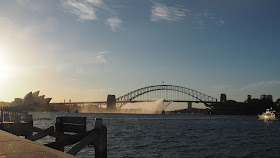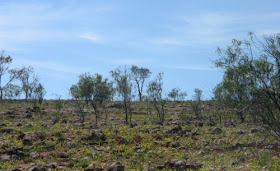First, here are some samples of a Sydney New Year's Eve, taken from expensive seats on Pinchgut, two years back. This year, we and our standard NYE friends will dine at a quiet restaurant away from the lowing herd, then walk back to our house to see the New Year in, on a north-facing balcony, looking away from the glows in the sky. After almost 50 years of harbour fireworks (the first we saw were in 1970), we don't like the discomfort and the heaving crowds.
Among the guests on Pinchgut were two Scots couples who come out each year for the fireworks on the harbour. I fear they may have had to find a new vantage point this year, as the restaurant on the island seems to have disappeared. Our Australian celebration of New Year's Day owes a lot to our Scots heritage. Perhaps I am a biased observer. As my surname implies, my ancestors were Scots. My family has been here since early colonial days, but we still keep many of the old traditions intact.
 |
| Beforehand |
 |
| Things happened to amuse the waiting crowds. Remember the bridge, because it plays a role. |
 |
| The sun set, but it wasn't 9 pm yet. |
 |
| Finally, the show began. Look for the bridge and the Opera House. |
 |
| Look for the bridge and the Opera House. These are our tribal icons. |
Among the guests on Pinchgut were two Scots couples who come out each year for the fireworks on the harbour. I fear they may have had to find a new vantage point this year, as the restaurant on the island seems to have disappeared. Our Australian celebration of New Year's Day owes a lot to our Scots heritage. Perhaps I am a biased observer. As my surname implies, my ancestors were Scots. My family has been here since early colonial days, but we still keep many of the old traditions intact.
Even in my generation, there has always been at least one
piper in the family to welcome in the New Year with a skirl, and the bagpipe
remains my favourite solo instrument, for I spent my earliest New Year's Eves,
standing directly beneath my father's chanter (that's the lowest pipe, the one
you twiddle on), taking in the sound and the smell of the pipes.
Perhaps I will learn to play the pipes when I retire. I will be in good company if I do, for I know
of just the pipe band for me, made up entirely of old and retired ‘Scots’, most
with broad Australian accents. Some
traditions die hard, even under an Antipodean sun.
Others may celebrate their New Year's Day by nothing more
than a day at the beach, or around a suburban backyard pool. Still, some hardy traditional types will
spend the day at a Highland Gathering, engaging in all sorts of strange
activities like tossing the caber and wild dancing to pipes that serve to
remind them of the hangover they still bear from the night before.
Traditionally, anybody can be a Scot on that day. My father knew a champion piper called Colin
Campbell who was, as it happens, one of the original Australians. In those days, whites would stress further
that Colin was a ‘full-blooded aboriginal’.
Be that as it may, he would appear each year in the New Year's Day
piping competitions to play his own spirited rendition of ‘A man's a man for
a'that’, and often to take prizes for his playing. Those who know their Burns, of course, will
see Colin's point . . .
But Sydney has always had its unusual Scots. A hundred years ago, a Chinese merchant of
Sydney, one Quong Tart by name, was popularly known to one and all as ‘Quong
Tartan’. He came to the Australian
goldfields as a small boy, and was taught English by Scots people, so his
accent was well suited to his nickname.
Historical accounts mention that he was an accomplished reciter of the
poems of Robbie Burns, including, I imagine, ‘A man's a man for a'that’.
One of the things which strikes tourists about Sydney is the
huge range of faces on the street, but this is by no means new. Now, we call it ‘multiculturalism’, but it
used to happen a hundred years ago as well.
Here is what ‘James O'Connell’ wrote in 1836, preserving his spelling:
In George street, the grand
thoroughfare, the visiter is amused with the motley group of divers nations,
kindreds, and tongues that he encounters.
New Holland is less exclusively the residence of convicts than the reader
may have imagined. Settlers and visiters
from all portions of the globe — Spaniards, Frenchmen, Englishmen, Americans,
Chinese, Malays, Kanakas or South Sea Islanders, the latter arriving in whale
ships, add variety to a scene which, without them, would be varied enough.
‘O'Connell’ was an escaped convict who had clearly spent
several New Year's days here before he escaped to Ponape (Pohnpei) in what was
then the Caroline Islands, and later to the United States, but let us stay with
the present, for now.
Other Australians will spend New Year's Day in the
bush. No, not in A bush, but in the bush. That is, in what other lands might call a
wilderness, a forest, a jungle, or even a heath. To us, these are all one and the same: they
are all ‘bush’. Where other nations go
hiking or back-packing, we go bush-walking.
Last century, we never had highwaymen, but we always had our
bushrangers. We took the word "bushranger" from the
Americans, who used it to mean anybody who roamed freely through the forests,
but it soon took on the meaning of an armed robber.
‘Bush’ can also mean anything rural, not of the city, as in
‘the city or the bush’, or as in a classic ribald poem, ‘The Bastard from the
Bush’, but mainly it refers to those patches of native Australian vegetation which
are to be found, even in the middle of a city of nearly four million people
like Sydney.
New Year's Day will be a hot and listless high summer day,
so the sensible thing to do is to find a shady spot beside a creek, to swim a
bit, to eat a bit, to drink a bit, to relax and enjoy the quietness. One of the joys of Sydney is that you can
find clean cool water in a quiet gully, within an hour of the very centre of
the city. The most preferred housing
sites have a harbour view, closely followed by those looking over, and
surrounded by, bush.
Of course, this can also a drawback, for those patches of
bush can flare up into cruel bushfires, but that is something most people
prefer not to think about on New Year's Day.
It is high summer, there is cricket on TV, beer in the fridge, and tomorrow will be a time to relax, at least for now.
I might just spend a few days in the bush. After all, ours is an evolving culture.
Still, bliadhna mhath ur.
I might just spend a few days in the bush. After all, ours is an evolving culture.
Still, bliadhna mhath ur.




















